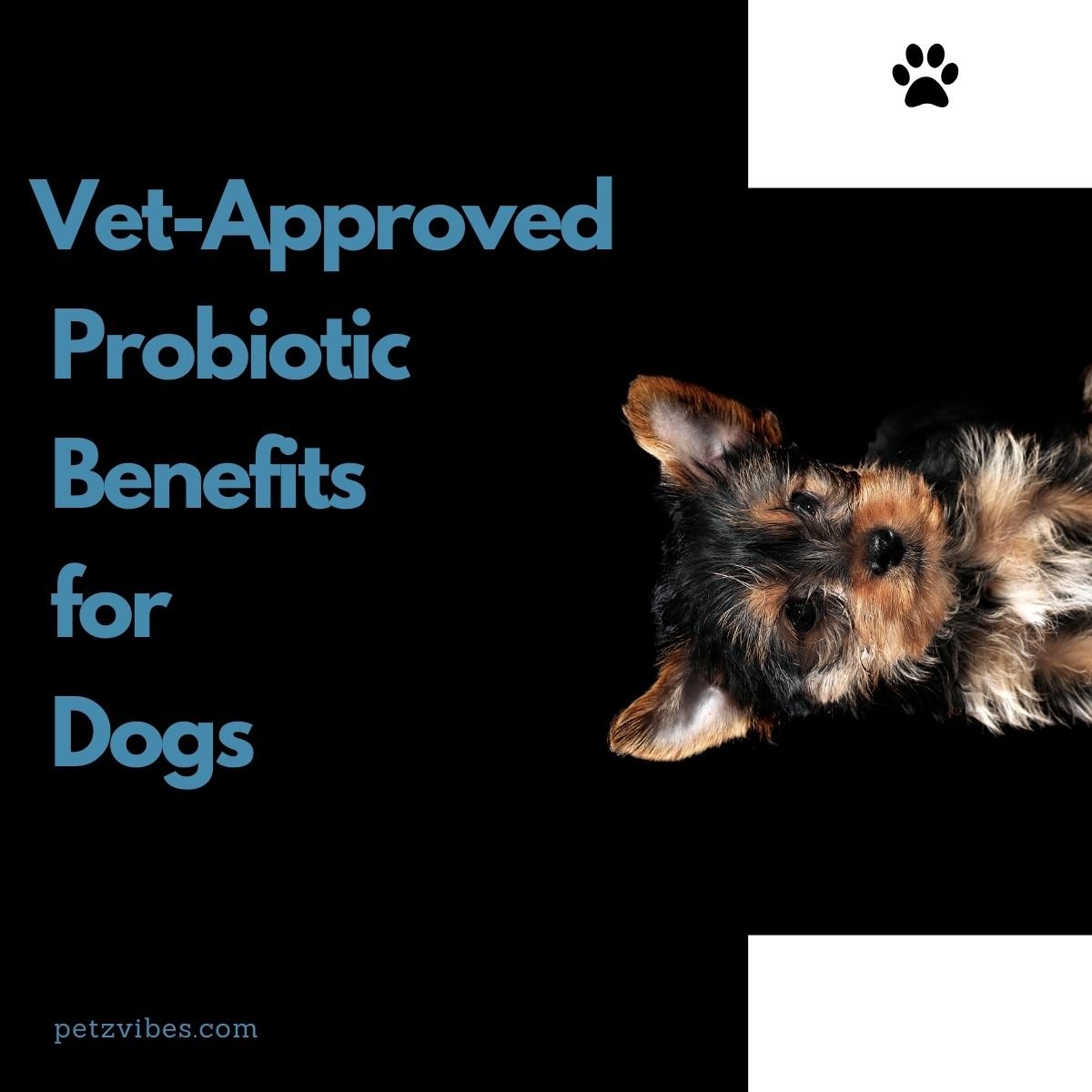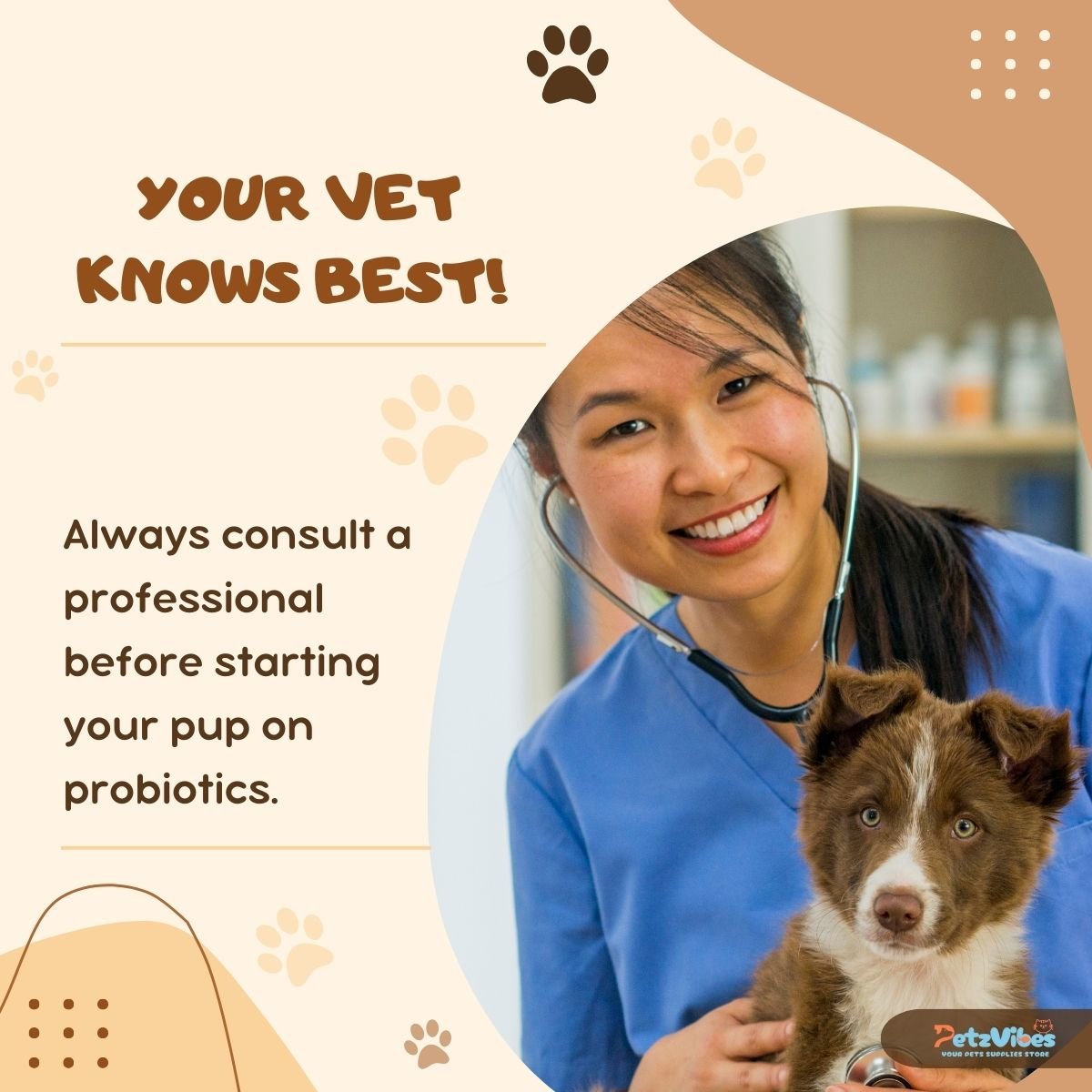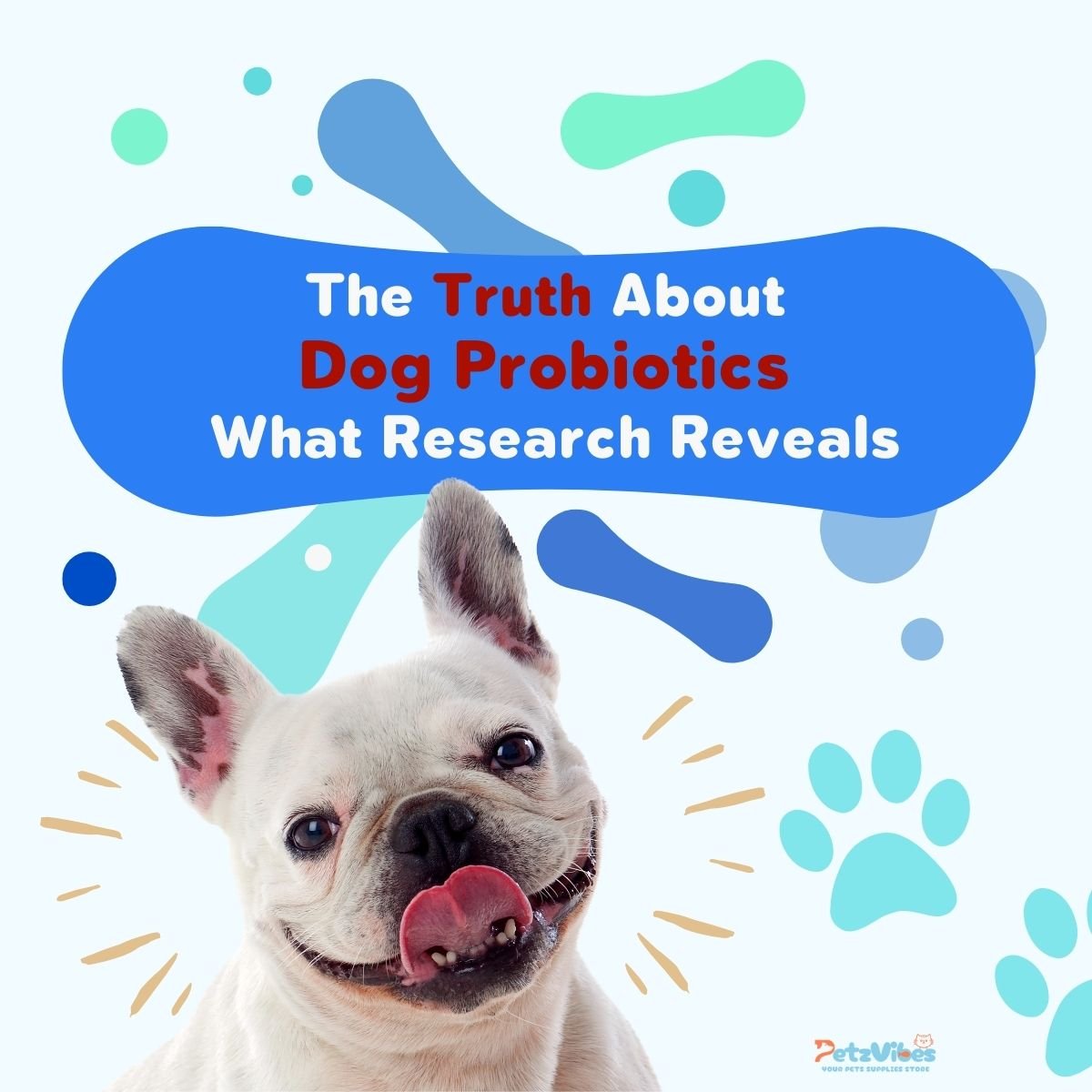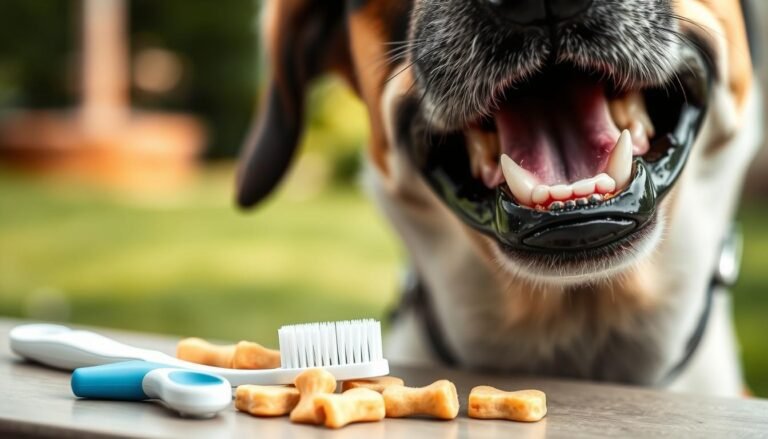“60% of dog owners report digestive issues in their pets—could probiotics be the missing key?”
You’re not alone if you’ve ever wondered, “Are dog probiotics worth it?”. More pet parents are taking these gut-friendly supplements to tackle everything from upset tummies to itchy skin. But do they work? Let’s cut through the hype and explore the science-backed benefits—plus some surprising perks you won’t find in most blogs.
Spoiler: Probiotics aren’t just for digestion. Emerging research suggests they might help your pup’s mood and immune system!
🔑 Key Takeaways: Dog Probiotics
- Worth It For: Digestion, immunity, allergies, puppies & seniors
- Avoid For: Viral infections, severe organ disease
- Best Strains: B. animalis (immunity), S. boulardii (diarrhea), B. longum (anxiety)
- Start Slow: 25% dose → full dose over 7 days
- Timeline: Diarrhea (1-3 days), allergies (4-8 weeks), immunity (3+ months)
- Human Probiotics? No – use dog-specific formulas
- Side Effects: Rare (usually mild gas/bloating)
- Storage: Some need refrigeration; shelf-stable options exist
Disclosure: PetzVibes.com is a free online platform that provides valuable content and comparison services. To keep this resource free, we may earn advertising compensation or affiliate marketing commissions from the partners featured in this blog.
🔬 What Are Probiotics? (Beyond the Basics)
Probiotics are live microorganisms—mostly “good” bacteria and some yeasts—that support your dog’s gut health. Think of them as tiny helpers keeping your pup’s digestive system balanced. But there’s more to the story than adding good bacteria to your dog’s gut!
Probiotics vs. Prebiotics: What’s the Difference?
| Probiotics | Prebiotics |
|---|---|
| Live bacteria/yeast (e.g., Lactobacillus) | Non-living fibers (e.g., inulin, FOS) |
| Add beneficial microbes directly to the gut | Feed and support existing good bacteria |
| Found in supplements, yogurt, and kefir | Found in chicory root, bananas, and asparagus |
“Probiotics introduce beneficial microbes, while prebiotics act like fertilizer to help them thrive.”
Key Facts About Dog Probiotics
-
Dogs Need Different Strains Than Humans
-
Canine-specific strains like Bifidobacterium animalis and Enterococcus faecium are most effective for dogs. Human probiotics may not provide the same benefits.
-
-
Not All Probiotics Survive Digestion
-
Many probiotic bacteria can’t survive stomach acid. Look for products with:
-
-
-
- Delayed-release capsules
- Microencapsulation technology
- Shelf-stable strains
-
-
Yeast Probiotics Can Be Powerful Too
-
Saccharomyces boulardii (a beneficial yeast) is particularly effective against diarrhea in dogs.
-
-
The Gut-Brain Connection 🧠🐕
-
Emerging research suggests a link between gut health and behavior in dogs. A healthy microbiome may help reduce anxiety and stress-related behaviors.
-
🛠️ How Dog Probiotics Actually Work in Your Pup’s Body
You’ve probably heard that probiotics are “good for gut health,” but what does that really mean? Let’s break down exactly how these microscopic helpers benefit your dog:
The 3 Key Actions of Probiotics
-
The Crowd Control Effect
-
Picture your dog’s gut like a crowded subway train. Probiotics are the polite passengers that push out the rowdy ones (harmful bacteria) by:
-
- Taking up space so that harmful microbes can’t settle
- Stealing their food sources
- Releasing natural antibiotics that stop bad bacteria from growing
-
- Gut Lining Repair Crew
-
A healthy gut lining acts like a bouncer, deciding what gets absorbed and stays out. Probiotics help:
-
-
-
- Tighten the “gaps” between gut cells (reducing leaky gut)
- Produce butyrate – a compound that feeds gut lining cells
-
-
Immune System Training Camp
-
70% of your dog’s immune cells live in their gut! Probiotics teach these cells to:
- Recognize real threats (like viruses)
- Ignore harmless things (preventing allergies)
-
Real-World Example:
When dogs take antibiotics, they drop a bomb on their gut, killing both good and bad bacteria. Probiotics act as reinforcements to rebuild the good bacteria population.
Why Survival Matters
Not all probiotics make it to where they’re needed! Here’s what affects their journey:
| Obstacle | How Good Probiotics Overcome It |
|---|---|
| Stomach acid | Acid-resistant strains or special capsules |
| Bile salts | Strains like Lactobacillus acidophilus can handle it |
| Time | Some need refrigeration, others are shelf-stable |
Pro Tip: Look for probiotics with “colonization factors” – these help the bacteria stick to the gut wall instead of just passing through.
Dog Owner FAQ
“How long until I see results from dog probiotics?”
- For diarrhea: Often within 24-48 hours
- For allergies/skin issues: May take 4-8 weeks
- For immune support: Best with continuous use
🐕 How Dog Probiotics Help Your Pup (Simple Science Explained)

Probiotics work like tiny helpers in your dog’s gut. Imagine your dog’s stomach and intestines as a garden. Probiotics are like adding good plants (beneficial bacteria) that crowd out the weeds (harmful germs). Here’s exactly how they help:
1. The Gut Balancing Act
Probiotics do three critical jobs:
- They take up space so that bad bacteria can’t grow
- They make the gut healthier by strengthening its lining
- They help with digestion by breaking down food better
A study from Texas A&M University found that dogs taking probiotics had 50% less diarrhea after starting antibiotics (source).
2. Immune System Boost
Did you know that about 70% of your dog’s immune system is in their gut? Probiotics help by:
- Training immune cells to fight real infections
- Reducing unnecessary inflammation (which causes allergies)
- Making special substances that protect against germs
3. Help for Common Problems
Here’s how probiotics help with specific issues:
| Problem | How Probiotics Help | Time to See Improvement |
|---|---|---|
| Diarrhea | Restores good bacteria balance | 1-3 days |
| Allergies | Reduces skin itching and ear infections | 4-8 weeks |
| Bad breath | Balances mouth bacteria | 2-3 weeks |
| Anxiety | Helps produce calming hormones | 6+ weeks |
Top 3 Vet-Recommended Probiotics
Here are some good options you can find at pet stores or online:
-
Purina Pro Plan FortiFlora
-
- Best for: Diarrhea recovery
- Contains: Enterococcus faecium
-
PetLab Co. Probiotic Chews
-
- Best for: Everyday gut health
- Contains: 5 beneficial strains
-
Nutramax Proviable
-
- Best for: Sensitive stomachs
- Contains: 7 different strains
When Probiotics Might Not Help
- During active vomiting (wait until the stomach settles)
- For parvovirus infection (needs emergency vet care)
- If your dog has a very weak immune system (check with vet first)
Tip: Start with a small dose and gradually increase over 5-7 days to avoid stomach upset.
🍖 Choosing the Right Probiotic for Your Dog (Simple Guide)
Picking a probiotic can feel confusing with so many options. Let’s break it down into simple steps to find what’s best for your pup.
1. Look for Dog-Specific Strains
Not all probiotics work the same! Dogs need special strains like:
- Lactobacillus acidophilus (helps digestion)
- Bifidobacterium animalis (boosts immunity)
- Enterococcus faecium (fights diarrhea)
Avoid human probiotics – they often contain strains that don’t help dogs.
2. Check the CFU Count (It’s Simple!)
CFU means “colony forming units” – how many good bacteria are inside. Here’s what to look for:
| Dog’s Size | Daily CFU Needs | Example Products |
|---|---|---|
| Small (under 20 lbs) | 1-3 billion | Zesty Paws Probiotic Bites |
| Medium (20-50 lbs) | 3-5 billion | Purina Pro Plan FortiFlora |
| Large (50+ lbs) | 5-10 billion | Nutramax Proviable |
Note: More isn’t always better! Too many CFUs can cause gas at first.
3. Pick the Right Form
Different forms work better for different dogs:
- Chews/Treats: Easiest for most dogs (like PetLab Co. chews)
- Powders: Good for mixing in food (like FortiFlora)
- Capsules: Best for precise dosing (open and sprinkle if your dog won’t swallow pills)
4. Special Needs Guide
Here’s what to look for common problems:
| If Your Dog Has… | Look For… | Example Product |
|---|---|---|
| Diarrhea | Saccharomyces boulardii yeast | Purina Pro Plan FortiFlora |
| Allergies | Lactobacillus rhamnosus | VetriScience Probiotic |
| Gas/Bloating | Multiple strain blends | Nutramax Proviable |
| Anxiety | Bifidobacterium longum | Purina Calming Care |
5. Storage Matters!
- Refrigerated probiotics (like some human ones) often die quickly
- Shelf-stable is best for most pet owners
- Check expiration dates – live bacteria lose power over time
Pro Tip: Start with a 14-day trial of any new probiotic to see how your dog responds before committing to a big supply.
6. When to Talk to Your Vet
Consult your vet if:
- Your dog has a serious illness
- You’re giving other medications
- There’s no improvement after 2 weeks
- You see vomiting or worse, diarrhea
Remember: The best probiotic is the one your dog will take daily! If they hate the taste, try a different form.
🐾 How to Introduce Probiotics to Your Dog (Step-by-Step Guide)
Adding probiotics to your dog’s routine should be easy and stress-free. Follow these simple steps to help your pup get the most benefits without tummy troubles.
1. Start Slow and Low
Just like humans, dogs need time to adjust to new gut bacteria. Here’s the safest way to begin:
Week 1: Give 1/4 of the recommended dose
Week 2: Increase to 1/2 dose
Week 3: Give 3/4 dose
Week 4: Full recommended dose
Example: If the package says “1 chew daily,” start with 1/4 chew for the first week.
2. Best Time to Give Probiotics
- With meals: Mix powders or open capsules onto wet food
- Morning vs night: Doesn’t matter much, but be consistent
- Avoid giving with:
- Hot food (can kill the bacteria)
- Antibiotics (wait 2 hours after meds)
3. What to Expect (Normal vs Concerning Reactions)
| Normal Adjustment | When to Worry |
|---|---|
| Slightly softer stools for 2-3 days | Watery diarrhea lasting >24 hours |
| Mildly increased gas | Vomiting or refusing food |
| More energy after 1-2 weeks | Lethargy or unusual behavior |
Pro Tip: Keep a simple journal to track changes in:
- Stool quality
- Energy levels
- Itching/scratching (for allergy dogs)
4. Making Probiotics More Effective
Boost your dog’s probiotic results with these easy additions:
Pair With:
- A spoonful of plain pumpkin (for fiber)
- Bone broth (helps gut healing)
- A varied diet (different protein sources help microbiome diversity)
Avoid:
- Sudden diet changes
- Too many processed treats
- Tap water with heavy chlorine (can kill good bacteria)
5. Troubleshooting Common Problems
Problem: My dog won’t eat the probiotic
Solutions:
- Try a different form (switch from powder to chew)
- Mix with a strong-smelling food (sardines work well)
- Ask your vet about flavored options
Problem: No changes after 2 weeks
Solutions:
- Check the expiration date
- Try a different strain
- Rule out other health issues with your vet
6. Long-Term Use Tips
- Store properly (cool, dry place away from sunlight)
- Watch for formula changes if you rebuy
- Take “probiotic breaks” every 3-4 months (1 week off)
- Rotate strains occasionally for better diversity
Remember: Every dog is different. What works for your friend’s Labrador might not be ideal for your Chihuahua. Patience and observation are key!
🚨 5 Dog Probiotics Mistakes Most Owners Make (And How to Fix Them)
Even well-meaning pet parents can accidentally reduce their dog’s probiotic benefits. Below are the most common errors – with science-backed solutions to maximize your dog probiotics’ effectiveness.
Mistake #1: Starting With Full Doses
The Problem:
-
Dumping a full dose of the best dog probiotics into your pup’s bowl immediately can cause gas or loose stools.
The Fix:
-
Use the “3-Day Ramp-Up Rule” for any new dog probiotics:
- Day 1-3: 25% of the recommended dose
- Day 4-6: 50% dose
- Day 7+: Full dose
Mistake #2: Choosing Human Probiotics
The Problem:
-
Many owners ask, “Can dogs take human probiotics?” While some strains overlap, most lack key canine-specific bacteria.
The Fix:
-
Only use formulas with proven dog gut health strains like:
- Bifidobacterium animalis (for immunity)
- Enterococcus faecium (for probiotics for dogs with diarrhea)
Mistake #3: Stopping Too Soon
The Problem:
-
Owners quit when symptoms improve, but research shows dog probiotics need:
- 14-30 days for digestive issues
- 6-8 weeks for allergy relief
The Fix:
-
Follow this dog probiotic dosage chart:
Condition Minimum Duration Diarrhea 2 weeks Allergies 8 weeks Immunity 3+ months
Mistake #4: Ignoring Prebiotics
The Problem:
-
Natural probiotics for dogs work best with prebiotics (their food source).
The Fix:
-
Add these dog immune system boosters to meals:
- 1 tsp canned pumpkin (per 20 lbs)
- ½ tsp ground flaxseed
- A splash of goat’s milk
Mistake #5: Using Expired Products
The Problem:
-
Best dog probiotics lose 50% of their potency after 6-12 months.
The Fix:
- Check expiration dates
- Store in cool, dry places (not bathrooms!)
- Look for shelf-stable options like Bacillus coagulans
🐶 Special Cases: Tailoring Dog Probiotics for Puppies, Seniors & Health Conditions
Not all dogs benefit from the same dog probiotics. Based on veterinary research, here’s how to customize probiotics for your dog’s unique needs.
1. Best Probiotic for Puppies
Puppies need gentle dog probiotics to support their developing systems:
- Key Strains: Bifidobacterium lactis (mimics mother’s milk) + Enterococcus faecium
- Form: Powders mixed into food (easier than probiotic dog treats for tiny mouths)
- Dosage: Start with 25% of an adult dose
Product Pick: Purina FortiFlora Puppy (best probiotic for puppies with 1B CFU/sachet)
2. Senior Dogs (Age 7+)
Aging dogs benefit from dog probiotics that address:
-
Joint Support: Strains like L. casei may reduce inflammation
-
Cognitive Health: Emerging links between gut health and brain function
-
Easier Digestion: Soft probiotic dog treats for dental issues
Research Note: A 2023 study found that seniors on probiotics had 30% fewer UTIs (immune boost).
3. Dogs with Chronic Conditions
| Condition | Probiotic Solution |
|---|---|
| IBD | Dog probiotics for IBD need S. boulardii + soil-based strains |
| Diabetes | B. animalis helps regulate blood sugar |
| Anxiety | B. longum BL999 reduces stress behaviors |
Critical Tip: Pair probiotics with colostrum or medicinal mushrooms for dog immune system boosters.
4. Post-Medication Care
After antibiotics/surgery:
- Wait 2 hours post-meds before giving the dog probiotics
- Use high-CFU formulas (5 B+) like Proviable-DC
- Continue for two extra weeks after treatment
“My Boxer’s recovery sped up when we used dog immune system boosters post-surgery.” – Lisa, veterinary nurse
🐾 Final Thoughts: Are Dog Probiotics Worth It?
After exploring the science, benefits, and practical applications, the answer is clear: high-quality dog probiotics can be a game-changer for many pups when used correctly. Here’s the quick recap:
✅ Worth It For:
- Digestive issues (diarrhea, gas, sensitive stomachs)
- Immune support (especially after illness/antibiotics)
- Allergy and skin health (when paired with vet care)
- Puppies & seniors with specific needs
❌ Not a Miracle Cure For:
- Viral infections (like parvo)
- Severe diseases (e.g., advanced kidney failure)
- Dogs already on balanced raw diets (may not need supplements)
Pro Tip: Always consult your vet before starting probiotics, especially if your dog has chronic conditions or takes medications.
❓ FAQ: 7 Most Common Dog Probiotic Questions
1. Can dogs take human probiotics?
No. While some strains overlap, dog probiotics need species-specific bacteria like B. animalis. Human formulas may lack key strains or contain unsafe additives.
2. How long until I see results?
- Diarrhea: 1–3 days
- Allergies/Skin: 4–8 weeks
- Immunity: 3+ months of consistent use
3. Are there side effects of dog probiotics?
Mild gas or loose stools may occur in the first 3 days. Stop if vomiting, severe diarrhea, or lethargy occurs (rare).
4. What’s the best probiotic for puppies?
Look for gentle strains like B. lactis (e.g., Purina FortiFlora Puppy). Start with a ¼ dose and monitor.
5. Can probiotics help my dog’s bad breath?
Yes! They balance mouth/gut bacteria. Pair with dental chews for best results.
6. Do probiotics need refrigeration?
Some do (check labels). Shelf-stable options (e.g., Bacillus coagulans) are more convenient.
7. Can I overdose my dog on probiotics?
Unlikely, but excessive CFUs may cause bloating. Stick to package doses unless your vet advises otherwise.
📢 Your Next Steps
- Pick a probiotic from our recommended tables.
- Start slow (25% dose → full dose over 7 days).
- Track changes in stool, energy, and skin/coat.
Have more questions? Drop them below! We’ll update this FAQ with vet-approved answers. 🐶

⚠️ Important Disclaimer
This blog post contains information based on scientific research and veterinary guidelines, but it is for educational purposes only. Every dog is unique, and its health needs can vary significantly.
🔹 Always consult your veterinarian before starting, changing, or stopping any supplements or medications for your pet.
🔹 Monitor your dog closely when introducing probiotics, and discontinue use if adverse reactions occur (e.g., vomiting, severe diarrhea, or lethargy).
🔹 Dosage and strain recommendations should be tailored to your dog’s age, weight, and health status by a qualified professional.
This content does not replace professional veterinary advice.
Resources
- International Scientific Association for Probiotics and Prebiotics (ISAPP)
“Using Probiotics to Support Digestive Health for Dogs”
https://isappscience.org/using-probiotics-to-support-digestive-health-for-dogs/ - AKC Canine Health Foundation
“Use of Probiotics to Reduce Symptoms of Inflammatory Bowel Disease (IBD) in Dogs”
https://www.akcchf.org/research/research-portfolio/1609.html - PMC (NIH National Library of Medicine)
“Gut Probiotics and Health of Dogs and Cats: Benefits and Mechanisms”
https://www.ncbi.nlm.nih.gov/pmc/articles/PMC10609632/






